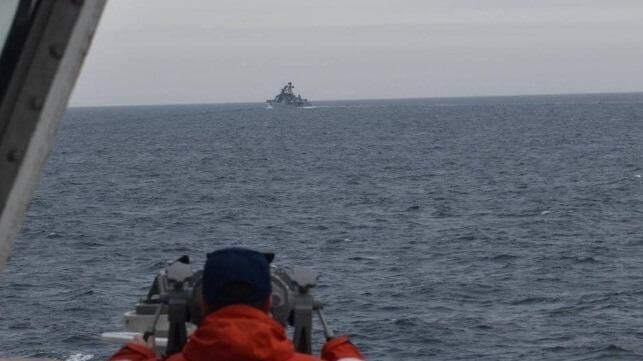Task Force of Russian and Chinese Warships Approaches Alaska

Last week, the U.S. Navy dispatched a small task force to respond to a group of nearly a dozen Russian and Chinese naval vessels near Alaska's Aleutian Islands, according to Alaska's senators.
In a joint statement, Senators Lisa Murkowski and Dan Sullivan (R-AK) said that a flotilla of 11 Chinese and Russian warships had conducted a patrol in the area of the Aleutian Islands. The U.S. Navy sent four destroyers and one P-8 maritime patrol aircraft to respond. The patrol remained in international waters and was not considered a threat, according to U.S. Northern Command.
Still, Alaska's political leaders found the transit troubling. Alaska's westernmost islands are closer to Russia than any other American terrain. "Whether you live in Alaska like I do, or on the East Coast of the United States, a very large surface action task force between our two main adversaries, probing very closely to United States shores is concerning," Sen. Sullivan said.
"This is a stark reminder of Alaska’s proximity to both China and Russia, as well as the essential role our state plays in our national defense and territorial sovereignty. Incursions like this are why we are working so hard to secure funding and resources to expand our military’s capacity and capabilities in Alaska," said Sen. Murkowski.
An American defense official told ABC that the U.S. had been monitoring the movements of the Russian and Chinese fleets and that the patrol past the Aleutians had been expected weeks in advance. A similar 10-vessel Russian-Chinese force was spotted off the coast of Japan on July 28, transiting northbound towards the Sea of Okhotsk.
China and Russia have been conducting frequent joint operations in the North Pacific since the start of the invasion of Ukraine, and are often found conducting maneuvers near Japan. They have also come to the Bering Sea before: Last September, a joint Russian-Chinese patrol of seven vessels passed near the Aleutians and were met by The U.S. Coast Guard cutter USCGC Kimball, the nearest American military vessel within range.
If a Russian-Chinese task force had entered within the 12-mile line that demarcates U.S. territorial seas, it would have been unwelcome but legal. Under international law, foreign warships have the right to transit through any state's sovereign waters, so long as they are making a through route and do not engage in military activity. These lawful voyages often attract an escort force from the coastal state, as seen during regular Russian transits through British waters.
